Leeward-Inseln |
|
|
|
| Übersicht – Contents: | |
Leeward-Inseln |
|
|
|
| Übersicht – Contents: | |
Flaggen – Flags: |
|
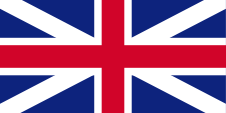 |
1671–1801, Flagge Großbritanniens – flag of United Kingdom, Seitenverhältnis – ratio = 1:2, Quelle/Source, nach/by: Die Welt der Flaggen   |
 |
1801–1871, Flagge Großbritanniens – flag of United Kingdom, Seitenverhältnis – ratio = 1:2, Quelle/Source, nach/by: Die Welt der Flaggen   |
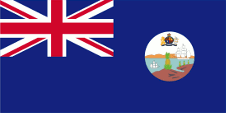 |
1871–1958, Flagge der Regierung (Staatsflagge) – flag of the government (state flag), Seitenverhältnis – ratio = 1:2, Quelle/Source, nach/by: Flags of the World |
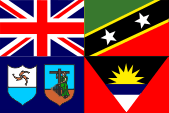 |
heutige Flagge des Leeward-Inseln Cricket Team – today's flag of Leeward Islands Cricket Team, Seitenverhältnis – ratio = 2:3 Quelle/Source, nach/by: Wikipedia (EN) |
Bedeutung/Ursprung der Flagge – Meaning/Origin of the Flag: |
|
| Die Flagge der Leeward-Inseln war ein sogenannter "Blue Ensign", ein dunkelblaues Flaggentuch mit einer Flaggendarstellung – dem britischen Union Jack – in der Oberecke. Der Union Jack wieß auf die Verbindungen zu Großbritannien hin. | The flag
of the Leeward Islands was a so called "Blue Ensign", a dark blue flag with
a flag depiction – the British Union Jack – in the upper left staff
quadrant. The Union Jack pointed to the connections to United Kingdom. ` |
Großbritannien hatte in Jahr 1864 ein Flaggensystem eingeführt, in dem:
Seit 1865 durften Schiffe von Kolonialregierungen einen Blue Ensign mit einem Badge (Abzeichen) im fliegenden Ende führen. |
United Kingdom introduced a flag system in 1864 in which:
Since 1865 ships of colonial governments were permitted to fly the Blue Ensign with a badge in the flying end of the flag. |
| Die Leeward-Inseln erhielten im Jahre 1871 ein eigenes Badge. Es zeigte eine Ananas an einer Küste mit zwei Schiffen. | The Leeward Islands became awarded an own badge in the year 1871. It showed a pineapple at a coast with two ships. |
| Die einzelnen Kolonien der Leeward-Inseln führten jedoch meist ihre eigenen "Blue Ensigns" mit einem eigenen Badge. Die Flagge der Leeward-Inseln wurde nur von der Regierung der Kolonie verwendet. | The separate colonies of the Leeward Islands had however mostly used their own "Blue Ensigns" with an own badge. The flag of the Leeward Islands was only used by the government of the colony. |
| Bis heute haben die Leeward-Inseln ihr eigenes, gemeinsames Cricket Team, dem folgende Gebiete angehören: Saint Kitts, Nevis, Anguilla, Montserrat, Britische Jungferninseln, Sint Maarten, US-amerikanische Jungferninseln. Die Flaggen einiger dieser Länder sind auf der Flagge des Leeward Islands Cricket Team vereint. | To this
day, the Leeward Islands have their own common cricket team, which includes
Saint Kitts, Nevis, Anguilla, Montserrat, British Virgin Islands, Sint
Maarten, US Virgin Islands.
The flags of some of these countries are united on the flag of the Leeward Islands Cricket Team. |
| Quelle/Source: Die Welt der Flaggen, Wikipedia (EN), Flags of the World | |
Wappen – Coat of Arms: |
|
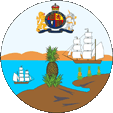 |
Wappen (Abzeichen) – Badge, Quelle/Source, nach/by: Flags of the World |
Bedeutung/Ursprung des Wappens – Meaning/Origin of the Coat of Arms: |
|
| Die Leeward-Inseln erhielten im Jahre 1871 ein eigenes Badge. Es zeigte eine Ananas an einer Küste mit zwei Schiffen. | The Leeward Islands became awarded an own badge in the year 1871. It showed a pineapple at a coast with two ships. |
| Quelle/Source: Wikipedia (EN), Flags of the World | |
|
interaktive Landkarte der Leeward-Inseln – interactive Map of the Leeward Islands |
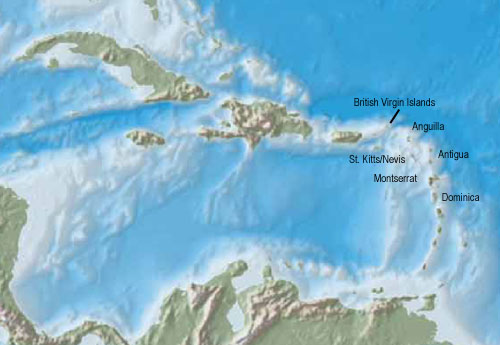 |
| Quelle/Source: Freeware, University of Texas Libraries, modyfied by: Volker Preuß |
|
|
Zahlen und Fakten – Numbers and Facts: |
|
|
|
|
|
|
|
|
|
|
|
|
|
|
|
Geschichte: |
| 1671 ·
Gründung der Kolonie der Britischen Leeward-Inseln (unter Zusammenfassung
der Besitzungen Britische-Jungferninseln,
Anguilla, St. Kitts, Nevis,
Montserrat, Antigua,
Dominika) 1816 · Auflösung der Kolonie 1833 · Neugründung der Kolonie 1871 · Dominika wird der Kolonie der Leeward-Inseln angegliedert, Einführung föderaler Strukturen mit eingeschränkter Selbstverwaltung für die einzelnen Inseln "Federal Colony of the Leeward Islands" 1940 · Dominika wird aus der Kolonie der Leeward-Inseln ausgegliedert und der Kolonie Britische Windward-Inseln angeschlossen 1956 · Umbenennung in "Territory of the Leeward Islands" 1958 · die Leeward-Inseln werden Teil der Westindischen Föderation 01.01.1960 · Auflösung der Kolonie in einzelne Kolonien: 1.) Britische-Jungferninseln, 2.) St. Kitts, Nevis und Anguilla, 3.) Montserrat, 4.) Antigua |
History: |
| 1671 ·
establishment of the colony of the British Leeward Islands (by unification
of the possessions of British Virgin Islands,
Anguilla, St. Kitts, Nevis,
Montserrat, Antigua,
Dominica) 1816 · dissolution of the colony 1833 · re-establishment of the colony 1871 · introduction of federal structures with limited self administration for the separate islands "Federal Colony of the Leeward Islands" 1939 · Dominica becomes excorporated out of the colony of the Leeward Islands and affiliated to the colony of the British Windward Islands 1956 · rename in "Territory of the Leeward Islands" 1958 · the Leeward Islands become a part of the Federation of the West Indies 1st of January 1960 · dissolution of the colony in several self-contained colonies: 1.) British Virgin Islands, 2.) St. Kitts, Nevis and Anguilla, 3.) Montserrat, 4.) Antigua |
| Quelle/Source: Wikipedia (EN), World Statesmen |
Ursprung des Landesnamens – Origin of the Country's Name: |
|
| Der Name "Leeward-Inseln" heißt übersetzt "die leewärts gelegenen Inseln" (also auf der windabgewandten Seite). So werden die im nördlichen Antillenbogen gelegenen Inseln noch heute bezeichnet. Der Name geht auf die Passatwinde dieser Breiten zurück. In Deutsch lautet die geographische Bezeichnung "Inseln über dem Wind". | The name "Leeward Islands" means "the leeward placed islands" (on the from the direction of the wind turned avay side). In this way the in the northern Lesser Antillas placed islands are called until today. The name has its roots in the trade winds of this geographical latitudes. In German they are called "Inseln über dem Wind" (Islands above the Wind). |
| Quelle/Source: Volker Preuß | |